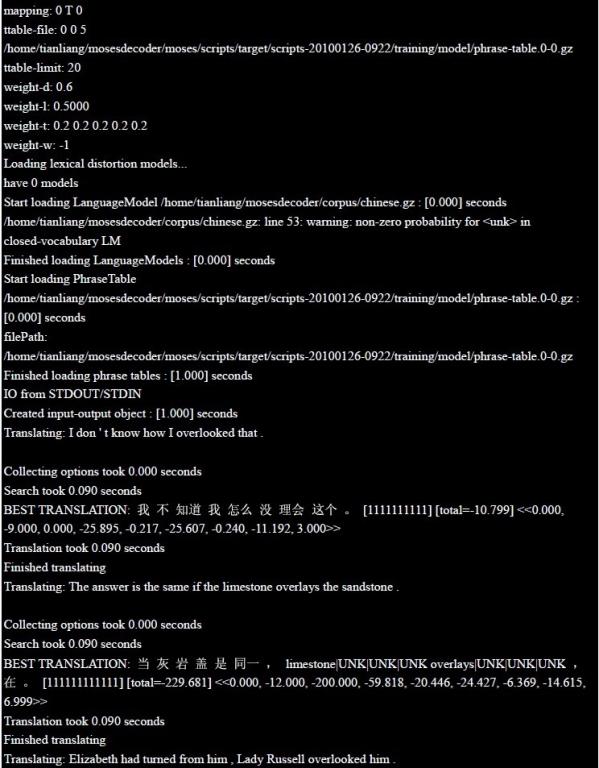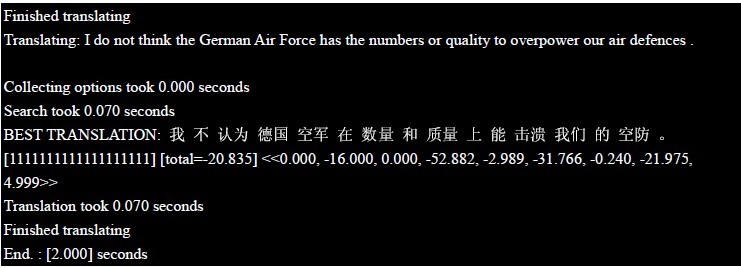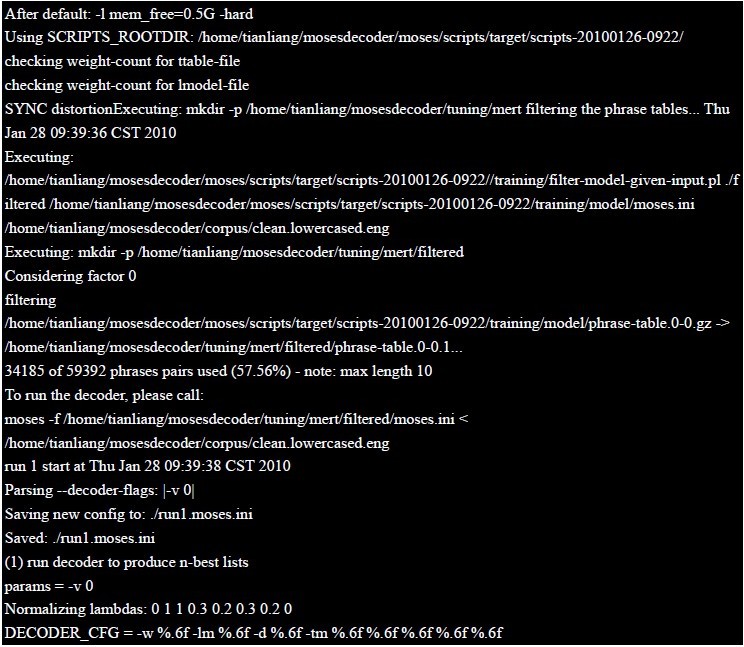Moses运行过程记录---Moses结果和评测(四)
来源:互联网 发布:js实现加减乘除 编辑:程序博客网 时间:2024/04/28 11:06
接下来的是Moses运行的结果和评测部分,具体的运行过程如下:

1. Copy the executable program moses to ~/scripts-20100126-0922/training/model.
2. Make a input file containing the sentences that wanting to be translated ~model/input .
I don ' t know how I overlooked that .
The answer is the same if the limestone overlays the sandstone .
Elizabeth had turned from him , Lady Russell overlooked him .
I do not think the German Air Force has the numbers or quality to overpower our air defences .
3. Translate the sentences using command like below:
tianliang@ubuntu:~/mosesdecoder/moses/scripts/target/scripts-20100126-0922/training/model$ ./moses -f
moses.ini <input> output



tianliang@ubuntu:~/mosesdecoder/moses/scripts/target/scripts-20100126-0922/training/model$ cat output


PART VI – Evaluation
There are two scripts perl that we can use to evaluate the translation quality---multi-bleu.perl and mteval-v11b.pl. The simpler one is the multi-bleu.perl.
multi-bleu.perl reference < machine translation-output
Reference file and system output have to be sentence-aligned (line X in the reference file corresponds to line X in the system output). If multiple reference
translation exists, these have to be stored in separate files and named reference0, reference1, reference2, etc.
All the texts need to be tokenized.
I choose 30 English sentences to be translated and named the output file “output”, and then I get the reference
translation of Chinese named “reference” .Now I can get the result:
tianliang@ubuntu:~/mosesdecoder/moses/scripts/target/scripts-20100126-0922/training/model$ ./multi-bleu.perl reference < output

The other popular script to score translations with BLEU is the NIST mteval script. It requires that text is
wrapped into a SGML format. This format is used for instance by the NIST evaluation and the WMT
Shared Task evaluations. Here I won’t talk too much about it .The following below is the grammar:

Parameters:

The command I that I will use is like below, here the “clean.lowercased.eng” is the English lowercased
sentences and “clean.chn” is the Chinese corpus.
tianliang@ubuntu:~/mosesdecoder/moses/scripts/target/scripts-20100126-0922/training$ ./mert-moses.pl
/home/tianliang/mosesdecoder/corpus/clean.lowercased.eng /home/tianliang/mosesdecoder/corpus/clean.chn
/home/tianliang/mosesdecoder/moses/moses-cmd/src/moses
/home/tianliang/mosesdecoder/moses/scripts/target/scripts-20100126-0922/training/model/moses.ini
--working-dir /home/tianliang/mosesdecoder/tuning/mert --root-dir
/home/tianliang/mosesdecoder/moses/scripts/target/scripts-20100126-0922/ --decoder-flags "-v 0"


The above is just the first iteration; the others are nearly the same. After a long running process
(18 iterations),we will get a configure file called “mose.ini”, we can get the BLEU score from the
first line as below:

I am amusing that Moses have so good translation. What you should know is that I didn't use a lot of
additional function, for example, the generation table, distortion parameters and so on. Although Moses
still can't translate very well on those that it hasn't met, just consider my corpus is just 1500 sentences.
You should understand it. People can not understand a word if he or she has not seen before! I am sure
Moses will have a better translation with large corpus. Of course, if I consider all the translation output,
the BUEU score will be lower.30 sentences are too small! But it doesn’t matter, here I just want to give
the operating steps!
I am preparing a large corpus about 100,000 parallel sentences with the help of my classmates and
some software. I will have a try when finishing it. During the preparing, I begin to feel that we should
let the machine to “learn” as people do. Consider our learning process, we first learn one word or one
sentence and then we can use it, maybe we cannot express it very well at first, but better after we can
learn grammar or rules. I think machine should have this process. What I want to do is to collect the
data from different fields, from the Peoples ' names to special terms, from short sentence to long sentences.
I do by step by step and let machine to learn step by step too.
- Moses运行过程记录---Moses结果和评测(四)
- Moses运行过程记录---Moses软件的安装(二)
- Moses Running Process and Steps :Moses运行过程记录---Moses运行前的准备(一)
- Moses运行过程记录---Moses语言模型和翻译模型构建(三)
- Moses
- Moses使用问题记录
- MOSES系统训练中间过程和意义详解
- Installing Moses
- Moses 安装
- 机器翻译系统moses报错记录
- 运行 Moses 期间遇到的问题
- MOSES统计机器翻译系统实现过程
- MOSES统计机器翻译系统实验过程
- MOSES的高级特征和功能
- Ubuntu上搭建和测试翻译Moses
- Moses的安装、训练和优化
- 利用开源工具搭一套汉英翻译系统(四):解码器Moses
- 使用Moses搭建一个机器翻译系统及实验记录
- 活动目录环境下Apache单点登录(SSO)的实现
- Java编程: 类的反射(第一节)
- Oracle配置安装
- Linux防火墙设置
- android tabHost布局之一 继承TabActivity并以activity布局
- Moses运行过程记录---Moses结果和评测(四)
- flex的获取远程服务器端返回数据并在页面展示
- Linux下和进程概念和查看
- C# 操作.eml文件
- 监控进程程序_能重新启动程序
- sql 删除重复行怎么写
- 关于GUI设计的Directx灵活顶点格式
- ASCII表
- 网站公司选址


